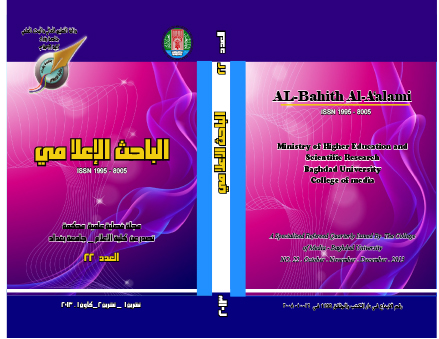Selective Exposure Patterns to the Iraqi Daily Newspapers and Its Motives for Iraqi University Students (College of Mass Communication - University of Baghdad as a Model)
DOI:
https://doi.org/10.33282/abaa.v5i22.307Keywords:
Selective, Exposure Patterns, the Iraqi Daily Newspapers, Iraqi, University StudentsAbstract
This study examines patterns of exposure of Iraqi university students to selective daily Iraqi newspapers and the motives of this exposure, as well as its associated factors that affect the average exposure. It tries to answer several questions, including those related to the levels of exposure of Iraqi university students to daily Iraqi newspapers and classification of patterns of selective exposure to daily Iraqi newspapers and the most prominent Iraqi daily newspapers that are selectively exposed by Iraqi university students. It also examines the motives of this selective exposure and factors that increase the degree of exposure to the daily Iraqi newspapers, and the most prominent stages in which Iraqi university students find their action of exposure to these newspapers.
This study consists of three axes. The first concerns the systematic framework in terms of defining the research problem, objectives and methodology used. The second, the study used the curriculum survey and questionnaire tool to obtain the required data. Whereas, the third one included theoretical input in terms of defining the concept of selective exposure and the concept of motivation, according to interpretations by the sciences of sociology and psychology, as well as for determining the types of exposure motives and patterns.
The study found a number of findings and conclusions that emerged from the field study by analyzing the questionnaire data and process it statistically using the percentage.
Downloads
References
2 . مصطفى عمر، مقدمة ومبادئ في أسس البحث العلمي الاجتماعي، دار الجماهير، طرابلس، 1980م، ص16.
3 . فرج عبد القادر، أصول علم النفس الحديث (القاهرة، عين للدراسات والبحوث الإنسانية والاجتماعية، 1999)، ص113
4 . فؤاد البهي، وسعد عبد الرحمن، علم النفس الاجتماعي (القاهرة: دار الفكر العربي، 1999) ص 40-41.
5 . علي قسايسية ، المنطلقات النظرية والمنهجية لدراسات التلقي دراسة نقدية تحليلية لأبحاث الجمهور في الجزائر ( 1995 – 2006 ) ،أطروحة دكتوراه ،جامعة الجزائر – كلية العلوم السياسية والإعلام – قسم علوم الإعلام والاتصال ، 2006 – 2007 .
6 . حسن عماد مكاوي، ليلى حسين، الاتصال ونظرياته المعاصرة ، (القاهرة، الدار المصرية اللبنانية، 1998) ،ص 246
7 . آلات روبرت ، التلفزيون والنقد المبني على القارئ، ترجمة حياة قاسم محمد، دراسات إعلامية ، المنظمة العربية للتربية والثقافة والعلوم، إدارة الثقافة، تونس ، 1991
8 . انظر بالانكليزية تموتي برنن وايوارت سكنر : نظرية الثقافة والاتصال ، الجامعة الامريكية في القاهرة ،2013 ، ص 12
9 .علي قسايسية ، مصدر سابق .
10 . د. حسن عماد مكاوي ، د. ليلى حسين السيد ،الاتصال ونظرياته المعاصرة ،ط8 ،الدار المصرية اللبنانية ،2009 ، ص246 – 247 .
11 . عمرو معديكرب حسين الهمداني ،مفهوم الاتصال وفق مقولات وظيفية ، مؤسسة الهمداني الثقافية –الدار المحمدية الهمدانية للدراسات والبحوث – اليمن ، ورقة بحثية ،21 مارس 2010 ، منقول من :الدكتور محمود عودة , مدرس علم الاجتماع بجامعة عين شمس , أساليب الاتصال والتغير الاجتماعي –دراسة ميدانية في قرية مصرية, 1971, دار المعارف بمصر , ص5
12 . بن يوسف بن خدة ، الجمهور والسلوك الاتصالي ، جامعة الجزائر -كليــة العلــوم السياسيــة و الإعـــلام ، قســم علــوم الإعــلام والاتصــال، ضمن رسائل الماجستير ، 2008 – 2009 .
13 . د. حسن عماد مكاوي ، د. ليلى حسين السيد ، مصدر سابق ، ص262 .
14 . المصدر السابق نفسه ، ص262 – 264 .
Downloads
Issue
Section
License
Authors retain copyright and grant the journal right of first publication with the work simultaneously licensed under a Creative Commons Attribution License (CC BY 4.0) that allows sharing the work with recognition of authorship and initial publication in ABBA journal.


















